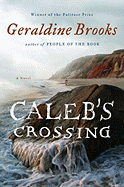
 Geraldine Brooks has a canny
knack for unearthing a piece of history, bringing it to light and engaging us
with it. She did so in Year of Wonders,
a novel of the 17th-century plague, and in March
(winner of the Pulitzer Prize), bringing to life the Civil War through the
absent father of Little Women. Most
recently, People of the Book (2008) retraced
the journey of the Sarajevo Haggadah. On the nonfiction side, her Nine Parts of Desire told the story of
Islamic women long before it was in the headlines.
Geraldine Brooks has a canny
knack for unearthing a piece of history, bringing it to light and engaging us
with it. She did so in Year of Wonders,
a novel of the 17th-century plague, and in March
(winner of the Pulitzer Prize), bringing to life the Civil War through the
absent father of Little Women. Most
recently, People of the Book (2008) retraced
the journey of the Sarajevo Haggadah. On the nonfiction side, her Nine Parts of Desire told the story of
Islamic women long before it was in the headlines.
She has done it again in Caleb's Crossing. Caleb (born Cheeshahteaumauck) is the younger son of Nahnoso, the Nobnocket sonquem (leader). His "crossing" takes place as he leaves his Wampanoag heritage and crosses over to the Puritan Christians in the late 1600s on Martha's Vineyard. Sonquem is just one of the many Wampanoag words Brooks incorporates, inviting the reader to learn what they mean in context. Her use of that vocabulary is part of her artful way of putting the reader exactly in the picture. The sonorous cadences and formal style used at that time, both in writing and speech, are the perfect vehicle for telling the story in an authentic and compelling way.
The narrator is Bethia Mayfield, 12 years old when the story begins. She is growing up in Great Harbor, a small settlement of pioneers and Puritans led by her father, the minister. She meets Caleb on the island and they form a secret friendship. Bethia is intrigued by a ritual that she witnesses; it is the beginning of her tolerance of different ways of worship. Three years later, Caleb comes to live in Bethia's home, invited by her father, who has converted him and now wishes to educate him, first at Cambridge School and then at Harvard College. This part of the story is based on fact: in 1665 a young man from Martha's Vineyard became the first Native American to graduate from Harvard College. Brooks marches forth on this slender historical snippet, creating a story of faith, love, hardship and loss.
Bethia longs for education, denied because of gender. Her brother, Makepeace, a dullard and a bully throughout most of the story, attends Cambridge because Bethia is indentured there to pay his fees. She works in the scullery, listening through windows and doorways to every lecture she can, thereby educating herself. When Makepeace is finally released from the hated bonds of academe, he becomes a real person and a friend to Bethia. Caleb is there at the same time, distinguishing himself as a scholar. His heritage is never left behind completely, however. Caleb's uncle, the powerful shaman Tequamuck, figures prominently in the story. His magic is brought to bear as revenge for the conversion of Caleb.
The outcome for all of these people--Caleb; Bethia and Noah, the man she is supposed to marry; Joel, Caleb's Wampanoag classmate; Bethia's parents; Samuel, son of the man to whom Bethia is indentured--is an altogether absorbing story by this masterful author of historical fiction.--Valerie Ryan
Shelf Talker: An absorbing story set in the 1600s on Martha's Vineyard, by a masterful author of historical fiction.

